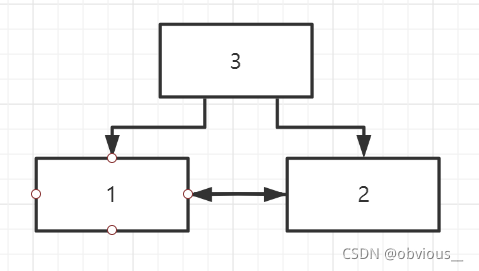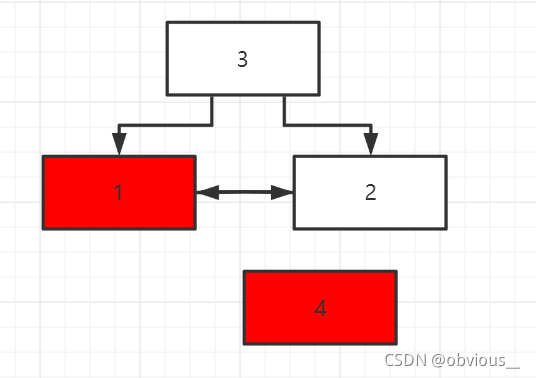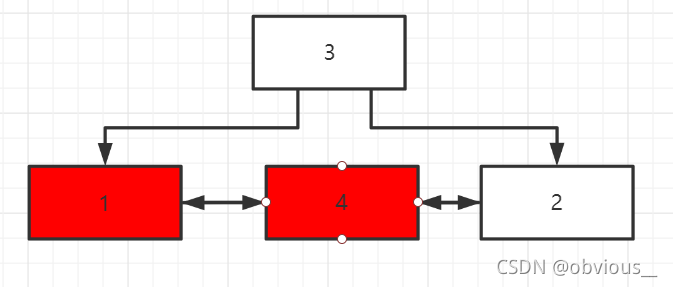B+树索引—并发控制
预备知识
《B+树索引—基本结构》
《B+树索引—查询》
《B+树索引—插入》
《B+树索引—分裂》
概述
最后,我们来讨论B+树的并发控制,准确来说应该是B-Link树的并发控制。并发控制是B-Link的精髓,B-Link树是在B+树的基础上进行了改造,而改造的目的就是为了提升并发性。在《B+树索引—基本结构》中,我们已经简要介绍过了B+树索引并发性的核心思想。基于这个核心思想派生出了许多精妙的实现,在本文中,我们来一一阐述。
分裂锁
基本
首先,我们来看看并发控制中锁最多的操作:分裂。明白了分裂的并发控制,才能更好的阐述其他操作的并发控制。

当前B+树的结构如图1所示,现在我们向节点1中插入一个元素,由于要向节点1插入元素,所以需要对节点1加X锁:

插入导致,节点1分裂,由于节点1发生分裂,所以X锁需要继续保持。现在我们需要新分配一个节点:节点4,用于迁移数据,所以节点4也需要加互斥锁:

接着,我们将节点1中分裂点之后的数据迁移到节点4。迁移完成后需要将节点4加入链表,由于加入链表需要修改节点2的前驱,所以需要对节点2加互斥锁:

注意,现在出现了第一个关键动作:持有节点1的锁,然后给节点1的右节点(节点2)加锁,即从左向右加锁。
节点4加入链表后,就可以释放节点2的互斥锁了:

现在,需要将节点4的<minkey, blockno>向上写入父节点(节点3),所以需要给节点3加互斥锁。

注意,现在出现了第二个关键动作:持有节点1和节点4的锁,然后给节1和4的父节点(节点3)加锁,即从下至上加锁。
向上写入完成后,整个分裂结束,释放掉所有的锁。
关键点
整个分裂流程有三个关键点:
- 在整个分裂过程中,同一时间最多只有三个节点持有锁。所以B+树的并发性是非常高的。
- 在分裂过程中,存在从左向右加锁的动作。
- 在分裂过程中,存在从下向上加锁的动作。
从左向右的加锁动作,意味着,B+树不能再有从右向左的加锁动作,否则会产生死锁;同样从下向上的加锁动作,意味着,B+树不能再有从上向下的加锁动作,否则也会产生死锁。
定位锁
定位流程
下面,我们来看看B+树的定位锁,在查询时,我们需要定位查询的开始位置,在查询日我们需要定位插入位置。定位过程,是从树的根节点出发,向下搜索的过程,是一个从上至下的遍历过程。在遍历过程中,我们需要读取节点中的数据,读取节点就意味着需要给节点加共享锁。前面我们说过,B+树中不能再有从上至下的加锁过程。所以每当需要读取下级节点时,都需要先将当前节点解锁,再给下级节点加共享锁。整个定位过程同一时间,只有一个节点持有锁。

问题
这样的并发控制流程会带来一个问题,如图8所示:

图8,展示了B+树分裂的中间状态,有进程Process A,向B+树中执行了插入操作,导致block1发生了分裂,但还未将block4进行向上写入。此时block1、block4、block2都有互斥锁,而block3没有锁。现在有另一个进程Process B向B+树中插入6。Process B会遍历B+树定位插入位置,于是执行了以下流程:
-
S Lock block3
-
二分法,找到6应该写入block1(因为6比8小)
-
UnLock block3
-
Lock block1
在Lock block1时,发现block1上的X锁,于是Process B进入等待。而此时Process A对block3加上X锁,执行向上插入,完成分裂,然后解锁block1,block4,block3,并唤醒Process B。Process B成功锁住block1。但显然6不应该插入block1,而应该插入block4。
解决方案
为了应对这样的情况,PostgreSQL提供了一个叫做_bt_moveright的函数,来实现一个右移的逻辑,该函数实现了这样的一个功能:
- 将scankey(当前为6),与节点的high key进行比较。
- 如果scankey > high key,就移动到当前节点的右兄弟。
而移动的方式是先Unlock当前节点,再Lock右节点。
遍历锁
回顾一下查询流程,我们利用索引查询时,分为定位和遍历两个阶段。定位到开始位置后,就需要进行遍历,直到满足遍历终止条件。遍历的目的是找到合法元组,并放入结果集。所以遍历过程又可以分为以下步骤:
- 执行step1:从indextuple中获取tid。
- 执行step2:根据tid获取元组。
- 执行step3:判断元组可见性。
- 执行step4:判断元组合法性。
- 执行step5:将合法元组加入结果集。
- 执行step6:获取下一个indextuple。
- 执行step7:执行step1。
这里,重要的不是步骤本身,而是通过这些步骤我们不难看出,取出一个indextuple之后,还需要干很多事。所以为了提高并发性。PostgreSQL总是一次性获取当前节点中所有满足索引条件的indextuple,存放到当前进程的私有内存中,然后解锁当前节点。后续对indextuple的遍历都是在私有内存中进行的。
从遍历方向上说,PostgreSQL存在向前遍历和向后遍历(向右遍历和向左遍历)。前面说过,分裂阶段存在从左向右上锁。所以在向左遍历时不能存在从右向左上锁。所以,不论是向前遍历还是向后遍历,在访问下一个节点之前,总是需要先解锁当前节点,这和_bt_moveright的逻辑一致。
所以遍历阶段可以归纳为下面几个步骤:
- step1:获取当前节点的所有indextuple,存放到进程私有内存。
- step2:UnLock当前节点。
- step3:遍历私有内存的indextuple,判断可见性、合法性,加入结果集。
- step4:Lock下一个节点。
根据遍历方向,下一个节点可能是右节点或左节点。这样的并发控制,使向前遍历和向后遍历有非常大的不同,下面我们来分别阐述。
向前遍历
向前遍历,即向右遍历。在上述并发控制下,向右遍历会有这样一个问题:

B+树的当前状态如图9所示,当前进程正在访问节点1,节点1上有共享锁,当前进程获取了节点1的所有indextuple之后,会Unlock节点1。然后当前进程会做一些列其他事情(遍历所有indextuple,判断可见性等等),当这些事情做完之后,当前进程就需要访问下一个节点,也就是节点2。然而在当前进程做其他事情的时候,有另外的进程对节点1做了插入,导致节点1分裂。

此时,节点1的右兄弟变成了节点3。那么我们应该遍历节点3么?不应该。因为节点3一部分数据是节点1分裂过来的,而节点1已经遍历过了,另外一部分数据是新插入的,这部分数据一定是不可见的,所以节点3不应该遍历,遍历只是浪费时间。当然,在当前进程遍历indextuple期间,节点1可能多次分裂,所以节点1和节点2之间可能不只节点3,而这些节点统统不应该遍历。所以正确的做法是,在我们UnLock节点1之前,需要获取节点的右兄弟的节点编号,即2,然后保存到进程私有空间。当需要访问下一个节点时,直接从私有空间中获取右节点编号,然后给右节点加锁。
那么,如果在当前进程遍历indextuple期间,节点2发生了分裂怎么办呢?这个没关系,因为分裂是向右分裂,所以按照现有逻辑顺着遍历下去就好。
向后遍历
遍历流程
向后遍历,即向左遍历。在上述并发控制下,向左遍历会有这样一个问题:

B+树的当前状态如图11所示,当前进程正在访问节点2,节点2上有共享锁。当前进程获取了节点2的所有indextuple之后,也会Unlock节点2,然后做其他事情,在这个过程中,节点1发生了分裂。如图12所示:

此时,节点2的左兄弟变成了节点3。那么我们应该遍历节点3么?应该,因为节点1还没有遍历过,如果我们采用向右遍历的逻辑,在Unlock节点2之前缓存节点2的左兄弟节点1,之后直接访问节点1,那么我们就会略过节点1的部分数据,从而造成数据丢失。所以,为了正确访问节点2的左兄弟,我们应该采用这样的步骤:
- step1:lock block2
- step2:get left_blk(block3)
- step3:unlock block2
- step4:lock left_blk(block3)
这4个步骤中,首先我们需要注意,step3和step4不能交换顺序,因为我们不能在节点2持有锁的时候,给节点3上锁,这是一个从左向右上锁的动作,如果节点3此时正在发生分裂,就有可能造成死锁。所以必须先解锁节点2,再给节点3加锁。然而,这由带来了一个问题,节点3有可能在step3和step4之间发生分裂,这样也会发生数据丢失。所以,我们需要更完善的逻辑。回到我们最初的目的:获取节点2的左兄弟,节点2的左兄弟,也就是右兄弟为节点2的节点。所以,我们需要加入一个判断流程:
- step1:lock block2
- step2:get current_blk(block2)
- step3:get left_blk(block3)
- step4:unlock current_blk(block2)
- step5:lock left_blk(block3)
- step6:check if ( left_blk->right_blk == current_blk)
- step7:if true then return
- step8:if false then move right
- unlock left_blk
- lock left_blk->right_blk
- step9:go to step6
这个流程的关键点是step6-step9。step6-step9是一个循环,核心思想是,锁定一个节点后,我们需要判断该节点右兄弟,是不是节点2。如果不是就右移到他的右节点,再次进行校验。这个逻辑很好很复杂,但这就万事大吉了么?不!还有坑爹的事情。在我们unlock了block2之后,block2可能会被删除!(由节点合并引起)
我们先来理解这个删除,首先在上面的步骤中,block2会被Unlock,但不会被Unpin。也就是说,block2的引用计数不可能为0。所以block2是不可能被彻底回收的。那么所谓的删除,只是将block2从链表中移除。如图13所示:

节点3的右节点变成了节点4,而节点4的左节点变成了节点3。然而节点2依然指向它原始的左右节点(这也是为什么不能Unpin节点2)。这样的变化会导致什么情况发生呢?导致step6-step9永远找不到一个右节点为节点2的节点。那么,我们应该如何来解决这个问题呢?首先,我们需要知道一个很重要的特性:节点2被删除,既然被删除,那么就不会有其他事务再向节点2插入或删除数据。那么节点2就再也不可能发生分裂。所以,节点2的右兄弟也就再也不会发生变化,永远都是节点4。在图13中,我们向右遍历找不到节点2,那么就应该去找节点2的右兄弟。因为此时,节点2右兄弟的左兄弟,就是之前节点2的左兄弟!
所以,在PostgreSQL中,step6-step9只会循环4次(PostgreSQL的经验值),如果循环4次后还是找不到右兄弟为节点2的节点,则跳出循环。然后判断节点2是否被删除,如果节点2被删除了,就去找节点2的右兄弟,这个节点的左兄弟就是我们要找的节点。于是重新goto到step1,执行全部流程。
在寻找节点2有兄弟的时候需要注意,节点2的右兄弟可能也被删除了,如图14所示:

所以,我们在找右兄弟的时候,应该去找第一个没有被删除的有兄弟。
代码实现
现在,我们来看看遍历的代码实现。向前遍历和向后遍历都是由_bt_steppage函数实现,代码如下:
/*
* so->currPos中记录了当前节点。
* PostgreSQL将当前节点中的indextuple缓存到进程私有内存后,就会UnLock当前节点。
* 所以此时该节点处于UnLock状态。
*/
static bool
_bt_steppage(IndexScanDesc scan, ScanDirection dir)
{
BTScanOpaque so = (BTScanOpaque) scan->opaque;
Relation rel;
Page page;
BTPageOpaque opaque;
Assert(BTScanPosIsValid(so->currPos));
/* Before leaving current page, deal with any killed items */
if (so->numKilled > 0)
_bt_killitems(scan);
/*
* Before we modify currPos, make a copy of the page data if there was a
* mark position that needs it.
*/
if (so->markItemIndex >= 0)
{
/* bump pin on current buffer for assignment to mark buffer */
if (BTScanPosIsPinned(so->currPos))
IncrBufferRefCount(so->currPos.buf);
memcpy(&so->markPos, &so->currPos,
offsetof(BTScanPosData, items[1]) +
so->currPos.lastItem * sizeof(BTScanPosItem));
if (so->markTuples)
memcpy(so->markTuples, so->currTuples,
so->currPos.nextTupleOffset);
so->markPos.itemIndex = so->markItemIndex;
so->markItemIndex = -1;
}
rel = scan->indexRelation;
if (ScanDirectionIsForward(dir))
{
/* 向前遍历 */
/* Walk right to the next page with data */
/* We must rely on the previously saved nextPage link!
* 获取之前缓存的右节点编号。
*/
BlockNumber blkno = so->currPos.nextPage;
/* Remember we left a page with data */
so->currPos.moreLeft = true;
/* release the previous buffer, if pinned
* 后面不会用到当前节点了,所以可以直接Unpin。
*/
BTScanPosUnpinIfPinned(so->currPos);
for (;;)
{
/* if we're at end of scan, give up
* 向右遍历,获取一个合法的右节点
*/
if (blkno == P_NONE || !so->currPos.moreRight)
{
BTScanPosInvalidate(so->currPos);
return false;
}
/* check for interrupts while we're not holding any buffer lock */
CHECK_FOR_INTERRUPTS();
/* step right one page */
so->currPos.buf = _bt_getbuf(rel, blkno, BT_READ);
/* check for deleted page */
page = BufferGetPage(so->currPos.buf);
TestForOldSnapshot(scan->xs_snapshot, rel, page);
opaque = (BTPageOpaque) PageGetSpecialPointer(page);
if (!P_IGNORE(opaque))
{
PredicateLockPage(rel, blkno, scan->xs_snapshot);
/* see if there are any matches on this page */
/* note that this will clear moreRight if we can stop */
if (_bt_readpage(scan, dir, P_FIRSTDATAKEY(opaque)))
break;
}
/* nope, keep going */
blkno = opaque->btpo_next;
_bt_relbuf(rel, so->currPos.buf);
}
}
else
{
/* 向后遍历 */
/* Remember we left a page with data */
so->currPos.moreRight = true;
/*
* Walk left to the next page with data. This is much more complex
* than the walk-right case because of the possibility that the page
* to our left splits while we are in flight to it, plus the
* possibility that the page we were on gets deleted after we leave
* it. See nbtree/README for details.
*
* It might be possible to rearrange this code to have less overhead
* in pinning and locking, but that would require capturing the left
* pointer when the page is initially read, and using it here, along
* with big changes to _bt_walk_left() and the code below. It is not
* clear whether this would be a win, since if the page immediately to
* the left splits after we read this page and before we step left, we
* would need to visit more pages than with the current code.
*
* Note that if we change the code so that we drop the pin for a scan
* which uses a non-MVCC snapshot, we will need to modify the code for
* walking left, to allow for the possibility that a referenced page
* has been deleted. As long as the buffer is pinned or the snapshot
* is MVCC the page cannot move past the half-dead state to fully
* deleted.
*
* step1:lock current block
*/
if (BTScanPosIsPinned(so->currPos))
LockBuffer(so->currPos.buf, BT_READ);
else
so->currPos.buf = _bt_getbuf(rel, so->currPos.currPage, BT_READ);
for (;;)
{
/* Done if we know there are no matching keys to the left */
if (!so->currPos.moreLeft)
{
_bt_relbuf(rel, so->currPos.buf);
BTScanPosInvalidate(so->currPos);
return false;
}
/* Step to next physical page
* 获取当前节点的左兄弟,对应前面的(step2~step9)
*/
so->currPos.buf = _bt_walk_left(rel, so->currPos.buf,
scan->xs_snapshot);
/* if we're physically at end of index, return failure */
if (so->currPos.buf == InvalidBuffer)
{
BTScanPosInvalidate(so->currPos);
return false;
}
/*
* Okay, we managed to move left to a non-deleted page. Done if
* it's not half-dead and contains matching tuples. Else loop back
* and do it all again.
*/
page = BufferGetPage(so->currPos.buf);
TestForOldSnapshot(scan->xs_snapshot, rel, page);
opaque = (BTPageOpaque) PageGetSpecialPointer(page);
if (!P_IGNORE(opaque))
{
PredicateLockPage(rel, BufferGetBlockNumber(so->currPos.buf), scan->xs_snapshot);
/* see if there are any matches on this page */
/* note that this will clear moreLeft if we can stop */
if (_bt_readpage(scan, dir, PageGetMaxOffsetNumber(page)))
break;
}
}
}
/* Drop the lock, and maybe the pin, on the current page
* 给当前节点解锁以及Unpin,主要是向左遍历时使用
*/
_bt_drop_lock_and_maybe_pin(scan, &so->currPos);
return true;
}
其中获取左兄弟的由_bt_walk_left函数来实现,代码如下:
static Buffer
_bt_walk_left(Relation rel, Buffer buf, Snapshot snapshot)
{
Page page;
BTPageOpaque opaque;
page = BufferGetPage(buf);
opaque = (BTPageOpaque) PageGetSpecialPointer(page);
for (;;)
{
BlockNumber obknum;
BlockNumber lblkno;
BlockNumber blkno;
int tries;
/* if we're at end of tree, release buf and return failure */
if (P_LEFTMOST(opaque))
{
_bt_relbuf(rel, buf);
break;
}
/* remember original page we are stepping left from */
//step2:get current_blk
obknum = BufferGetBlockNumber(buf);
/* step left */
//step3:get left_blk
blkno = lblkno = opaque->btpo_prev;
//step4:unlock current_blk
_bt_relbuf(rel, buf);
/* check for interrupts while we're not holding any buffer lock */
CHECK_FOR_INTERRUPTS();
//step5:lock left_blk
buf = _bt_getbuf(rel, blkno, BT_READ);
page = BufferGetPage(buf);
TestForOldSnapshot(snapshot, rel, page);
opaque = (BTPageOpaque) PageGetSpecialPointer(page);
/*
* If this isn't the page we want, walk right till we find what we
* want --- but go no more than four hops (an arbitrary limit). If we
* don't find the correct page by then, the most likely bet is that
* the original page got deleted and isn't in the sibling chain at all
* anymore, not that its left sibling got split more than four times.
*
* Note that it is correct to test P_ISDELETED not P_IGNORE here,
* because half-dead pages are still in the sibling chain. Caller
* must reject half-dead pages if wanted.
*/
tries = 0;
for (;;)
{
//step6:check if ( left_blk->right_blk == current_blk)
if (!P_ISDELETED(opaque) && opaque->btpo_next == obknum)
{
/* Found desired page, return it */
//step7:if true then return
return buf;
}
if (P_RIGHTMOST(opaque) || ++tries > 4)
//循环4次还没找到,就break
break;
//step8:if false then move right
blkno = opaque->btpo_next;
buf = _bt_relandgetbuf(rel, buf, blkno, BT_READ);
page = BufferGetPage(buf);
TestForOldSnapshot(snapshot, rel, page);
opaque = (BTPageOpaque) PageGetSpecialPointer(page);
//step9:go to step6
}
//到这里说明current_blk可能被删除了,所以需要判断current_blk有没有被删除
/* Return to the original page to see what's up */
buf = _bt_relandgetbuf(rel, buf, obknum, BT_READ);
page = BufferGetPage(buf);
TestForOldSnapshot(snapshot, rel, page);
opaque = (BTPageOpaque) PageGetSpecialPointer(page);
if (P_ISDELETED(opaque))
{
/*
* It was deleted. Move right to first nondeleted page (there
* must be one); that is the page that has acquired the deleted
* one's keyspace, so stepping left from it will take us where we
* want to be.
*/
//current_blk被删除,需要获取current_blk第一个没有被删除的右兄弟
for (;;)
{
if (P_RIGHTMOST(opaque))
elog(ERROR, "fell off the end of index \"%s\"",
RelationGetRelationName(rel));
blkno = opaque->btpo_next;
buf = _bt_relandgetbuf(rel, buf, blkno, BT_READ);
page = BufferGetPage(buf);
TestForOldSnapshot(snapshot, rel, page);
opaque = (BTPageOpaque) PageGetSpecialPointer(page);
if (!P_ISDELETED(opaque))
break;
}
/*
* Now return to top of loop, resetting obknum to point to this
* nondeleted page, and try again.
* 然后goto到line12,去找当前这个有兄弟的左兄弟。
*/
}
else
{
//current_blk没有被删除,需要校验下current_blk的左节点是不是真的不等于lblkno
//如果opaque->btpo_prev == lblkno就说明一定出了问题。
/*
* It wasn't deleted; the explanation had better be that the page
* to the left got split or deleted. Without this check, we'd go
* into an infinite loop if there's anything wrong.
*/
if (opaque->btpo_prev == lblkno)
elog(ERROR, "could not find left sibling of block %u in index \"%s\"",
obknum, RelationGetRelationName(rel));
/* Okay to try again with new lblkno value */
}
}
return InvalidBuffer;
}